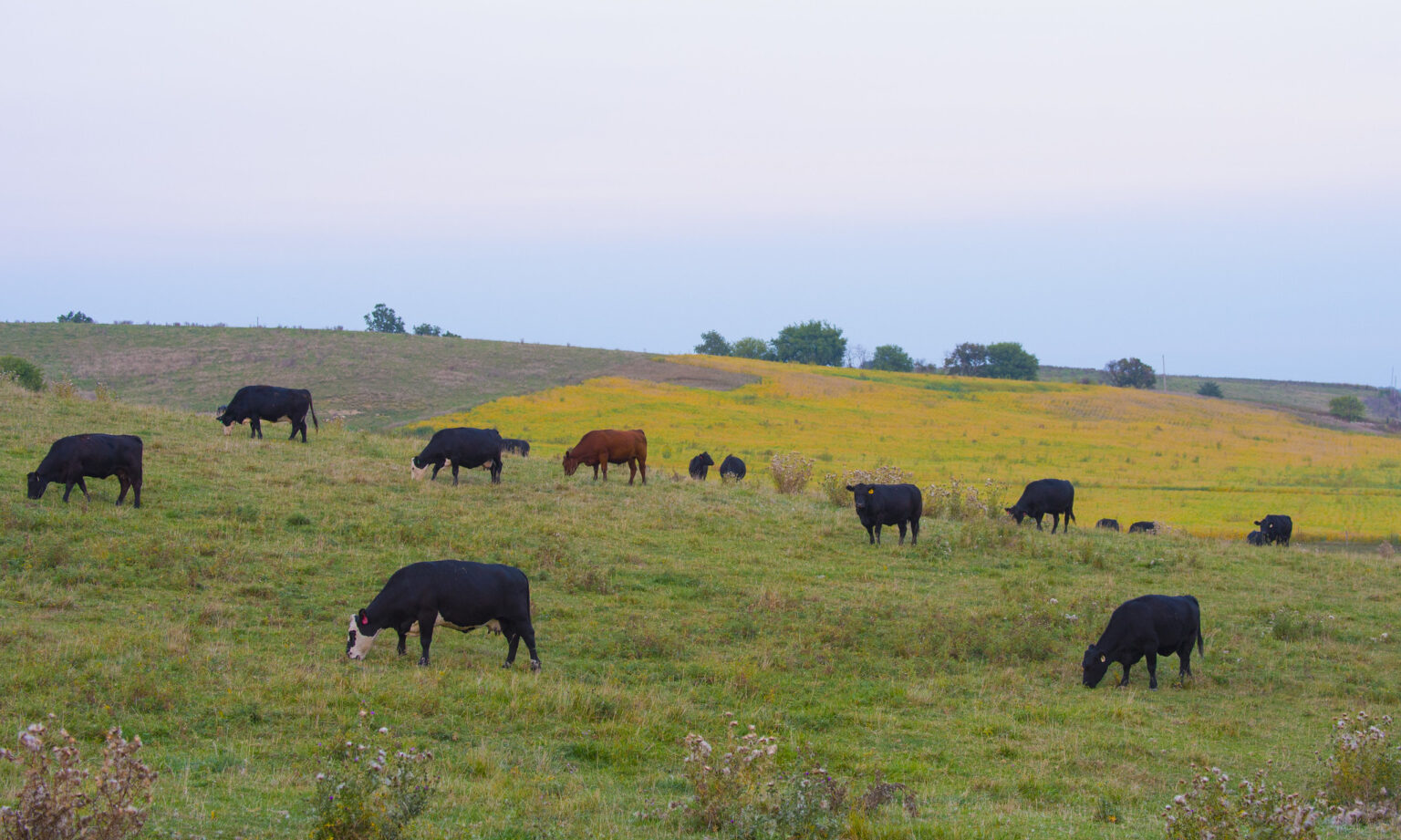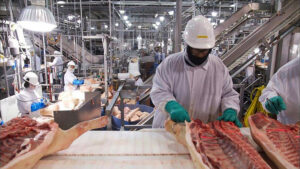10:28
News Story
Droughts, complicated by climate change, result in US beef herd hitting historic low
Nebraska and Missouri — two of the top 10 beef-producing states — experienced the largest decline in the quality of June pastureland since 2020 compared to the other top states
Thirty years ago, the weather on Annie Doerr’s family ranch felt reliable. Now that she’s taken over from her parents, it’s been anything but. In recent years, drought has made finding good pastureland for beef cattle to graze increasingly difficult.
“I always pray for a normal year,” she said, “which I don’t really know what that looks like anymore.”
Drought has affected operations at her 500-head beef cattle farm in Creighton, Nebraska, less than an hour from the South Dakota border.
In any given year, the nation experiences dry periods without rainfall. Livestock producers mitigate the effects by providing additional water sources directly to animals or crops, such as water lines to livestock or irrigation for crops. Droughts occur when dry conditions last longer than usual and water isn’t replenished to crops, groundwater, lakes or other bodies of water, resulting in water-supply problems, according to the United States Geological Survey.
During droughts, Doerr said she weans her calves off milk earlier than usual, a common practice in dry years, but one that can also put young cattle at higher risk of dying. She also slows the growth of her herd, and spends more money on sourcing feed for cattle.
This same scenario has played out again and again across the nation’s major cattle-producing states.
The size of the overall U.S. beef cattle herd has continued to decline since 1975, a trend largely attributed to an increase in global beef production and cattle imports. But at the beginning of 2024, the nation’s inventory of beef cattle hit a 61-year low, according to data from the U.S. Department of Agriculture.
In the nation’s top 10 beef-producing states — responsible for nearly 60% of the country’s beef production — half reported the lowest number of cattle since 1995 as of the beginning of this year, according to an Investigate Midwest analysis of the USDA’s data.
Droughts starting in 2020 are a contributing factor in the nation’s historically low beef inventory, according to USDA research. Nebraska and Missouri — two of the top 10 beef-producing states — experienced the largest decline in the quality of June pastureland since 2020 compared to the other top states, according to an Investigate Midwest analysis of USDA data.
Finding land with plentiful grazing for cattle is difficult in drought years. An analysis of USDA pastureland data shows that grazable Nebraska pastureland shrunk by a third since 2019 during the month of June.
Climate change has made dealing with droughts more complicated.
Current research shows climate change has caused more frequent large rainfall events coupled with months of zero precipitation. This volatility has made relying on typical weather patterns and grazing conditions difficult for the nation’s beef producers.
Doerr said a successful cattle operation comes down to having enough feed. Drought can ruin the available pasture to graze in summer as well as the harvested hay animals eat in the winter, leading some producers to cull their herds — or “get rid of mouths” — she said.
When a drought hits livestock producers, the ripple effect can last for years. Ranchers, like industry experts, also attribute recent drought years to the nation’s historic low for beef cattle.
And fewer beef cattle equals a reduced supply available to meat processing companies nationwide. The declining inventory has been linked to rising retail prices for beef products, according to market reports from the American Farm Bureau.
Currently, cattle market experts report that the price paid by meatpackers to beef cattle ranchers is expected to be an all-time high. Food industry experts told various media outlets in late 2023 that this price increase would translate into sticker shock for consumers.
The average retail price per pound of ground beef in January of this year was $5.03, a 5% increase compared to the same time in 2023, according to the U.S. Bureau of Labor Statistics. At the end of last year, the price of beef per pound peaked at $5.35, a 40-year high.
Dealing with drought
Dennis Todey, climatologist and director of the USDA’s Midwest Climate Hub, said drought affects agriculture differently across the country. In the Midwest, much of agricultural production is fed by rain and groundwater.
Climate change has complicated the region’s drought realities, Todey said. In recent years, the Midwest has seen significant rainfall and floods, then goes months without any precipitation, causing drought.
“You can have more overall rainfall, yet still have more drought,” Todey said.
Livestock producers now deal with weather whiplash — the result of climate change — of severely wet years, followed by intense, dry seasons.
The top beef cattle-producing states, in particular, have seen varying degrees of drought conditions during the last few years.
In 2021, for example, 30% of Nebraska was in various levels of drought in early June, when many ranchers require a good supply of pastureland for grazing. The next year, almost the entire state was in a drought during early June, according to the U.S. Drought Monitor.
In another example, none of Missouri was in a drought during early June 2022. During that same period of 2023, 86% of the state was in a drought, according to the drought monitor.
When droughts persist year over year, livestock production can take a major hit. Grasslands don’t have time to recover to sustainable levels. When rain doesn’t fall, ranchers are left with tough choices.
In some cases, ranchers transport water or alternative feed like corn to cattle, which then can increase production costs. Sometimes, the more financially sound decision is to cull animals instead.
When the grass doesn’t grow
In recent years, Nebraska pastureland has provided little to no feed for livestock during the month of June, according to USDA data.
Poor and very poor crop conditions result in almost total crop failure, according to the agency, and require producers to feed livestock supplemental food. In 2023, more than a third of all Nebraska pastureland was, at minimum, in poor condition throughout the month of June — the highest level for the state in 10 years, according to an Investigate Midwest analysis of USDA pastureland data.
In Missouri during the same time period, half of the state’s pastureland was at least in poor condition, which was the highest percentage seen in June in nearly 30 years.
Eric Bailey is an assistant professor and state beef nutrition specialist at the University of Missouri. He said that in a normal year, a rancher will lose around 20% of their herd, due to aging cattle, health issues, pregnancy failures, or natural death.
When drought conditions are worse than normal, producers kill off more animals due to increased costs for alternative feed and transporting water, leading to greater decreases in the herd’s original size. For the years of 2022 and 2023, the rate of beef cattle culled on farms was the second and third highest, respectively, since 2011, according to a February USDA report.
“(Cattle ranchers) should be expanding right now, but because we’ve been dry, people have been reluctant to keep heifers on the farm,” Bailey said.
The past few years of drought means there is a pent-up demand to expand cattle herd sizes, Bailey said.
“People were itching to expand in fall of 2022, and we were dry. Then the price of cattle increased dramatically in 2023,” he said. “We’ve just got to have growing conditions that people feel good about.”
An easing drought?
Snow storms in the Midwest at the beginning of 2024 are expected to bring relief from the recent run of drought years. As the snow melts, water will be restored to rivers, streams and groundwater systems in desperate need of replenishment.
Despite forecasts of reduced drought levels for 2024, ranchers will continue to recover from previous drought years.
Nebraska rancher Mackenzie Johnston runs a 450-head cattle ranch with her family in the Sandhills region of central Nebraska.
Last year was the first time she had to truck in hay from more than 500 miles away in Des Moines, Iowa, because of the substandard quality of grasses near her. She said this additional cost would have been too steep if not for the Livestock Forage Disaster Program, a federal initiative that provides financial help to agriculture producers during droughts.
During other drought years, Johnston said she would typically buy hay from South Dakota if Nebraska grass was in too poor condition.
Johnston said 2022 was “so darn dry” and the ranch’s hay production was minimal. When the operation had levels of grass too low for grazing, cattle became more expensive to raise. She said any cow that gave birth to sick calves or had an overall lower reproductive rate was sent to slaughter — or in her words, “went to town.”
Johnston said their operation has survived through the years because they focus on being conservative with the hay they feed their cattle. If there’s any grass on the ground, her cattle aren’t being “pampered” and are wrangled to graze outside, rain or shine.
Nebraska meteorologists expect this year to have more precipitation compared to last year. However, climate experts in the state warned state officials in 2023 that there needs to be better drought preparedness in the coming years to prevent future impacts to agriculture.
At the end of January, Johnston said there was nearly a foot of snow on the ground, followed soon after by acres of melt and muck.
“We have mud up to our knees, so even thinking about it being dry is just crazy,” she said.
This article first appeared on Investigate Midwest and is republished here under a Creative Commons license.
Our stories may be republished online or in print under Creative Commons license CC BY-NC-ND 4.0. We ask that you edit only for style or to shorten, provide proper attribution and link to our website. AP and Getty images may not be republished. Please see our republishing guidelines for use of any other photos and graphics.





